Whilst the idea of fake news has only recently become a disturbing phenomenon, winning the award of ‘Word of the Year’ in 2017 thanks to the conspiracy-ridden Presidency of Donald Trump, the idea of false advertising and national deceit has existed for centuries.
The young Czech filmmakers Filip Remunda and Vít Klusák realised this truth, soon to be popularised, back in 2004, releasing their quietly hilarious stab at corporate fakery with Czech Dream.
Created as an elaborate graduation project whilst they were at university, the grand concept of Remunda and Klusák’s surreal documentary was to plan, advertise and create the facade for a brand new supermarket in the Czech countryside.
They did it to see how many people would flock to the ‘spectacular’ opening day. Sounding like an intricate YouTube prank, the work of the young Czech filmmakers was as boisterous as the modern-day online philanthropist MrBeast but was grounded in a large dose of clever satire.
Devising the name Český sen (Czech dream) for their new hypermarket, the filmmakers create a grand advertising campaign for the fake store, using provocative messages like ‘don’t come’ and ‘don’t spend’, which appeared in newspapers and on vast billboards.
Donning fitted suits, the two filmmakers become the ‘businessmen’ behind the new supermarket, taking their prank very seriously as they create a jingle for several TV adverts and even get the opinion of a focus group.
Just like every great childish prank, it is the payoff that remains the most memorable part of Czech Dream, with the film’s final sequence being an uncomfortable unravelling of the inevitable, with Remunda and Klusák capturing the drama to hilarious effect. Though as the film’s epilogue explores, the context of their prank remains the most pertinent message, highlighting several real-life issues like the Jester of the King’s court.
As well as a satisfying dissection of consumerist culture, the filmmakers present the film as a protest against the Czech Republic’s bid to be part of the European Union, suggesting that the political mission is nothing more than an advertising ploy, similar to the ethereal promises of supermarket advertising.
True, their trick is somewhat mean-spirited, encouraging hundreds of Czech residents to flock to a fake supermarket only to mock their arrival. However, the results are undoubtedly fascinating, with the aftermath driving a national conversation.
Rudimental and fascinating, Czech Dream explores the intricacies of how individuals can be roped into corporate lies with the promise of low prices and the ethereal guarantee of access to a higher level of self-worth.
Prague Public Transit Company (DPP) has published the results of an architectural competition for the design of the Depo Zličín metro station building for line B.
It will be designed by the Czech studio Petr Stolín Architekt, and construction should start in 2026.
Depo Zličín will extend line B from the original Zličín terminus and become the 62nd station of the Prague metro. According to the company, it will be above-ground and will be used primarily by drivers, passengers from suburban lines, and later also by residents of new apartment developments in the area. The construction of a parking garage is also planned.
“For the first time in the nearly fifty-year history of the Prague metro, a solution for the station was sought in an international architectural competition. Next to the station, we will also build a new P+R parking garage for at least 600 cars. In the western part of Prague, an important interchange between automobile traffic and public transport will thus be created, which will relieve the center of unnecessary traffic. Thanks to this, passengers from the very edge of the city can get to the center by metro within about 30 minutes from parking,” said Adam Scheinherr (Praha Sobě), deputy mayor for transport and chairman of the supervisory board of the transport company, in a press release.
The station building will be partially embedded in the slope, and the roof will be accessible by foot. The architects hope that exhibitions or other events will be held there.
“The simple form of the building is complemented by a landscape of trees and sculptures. Light transmission and abundance of views is the main and probably the most typical element that the architecture of a metro station offers,” authors Petr Stolín, Jan Stolín, Alena Mičeková and Josef Stolín described their proposal.
They will now finalize the design with the transport company and the designer and prepare an architectural study.
“The construction of the new Depo Zličín metro station is expected to start in 2026 at the earliest,” added Aneta Řehková, spokeswoman for the transport company.



Since the devastating floods of August 2002, the Prague municipality has invested four billion crowns in the city’s flood protection.
Some 20 kilometers of barriers have been built, along with flood gates, and a pumping station. Modifications to rivers and streams in the region have also taken place, returning previously straightened streams to their original beds. Moreover, a new flood wall could protect the Prague Zoo from flooding in the future.
The flood, which happened 20 years ago on August 12-15, damaged, among other things, almost two dozen stations of the Prague metro. In total, the flood caused 27 billion crowns in damage in Prague alone, and destroyed dozens of houses. Over 50,000 residents had to be evacuated.
The city’s anti-flood measures now include earthen embankments, solid concrete walls and aluminum mobile barriers. The total length of the protection is 19.26 kilometers. Of this, 6.8 kilometers of mobile embankment is made up and its height is from 0.2 to 6.27 meters. Walls are built beneath all barriers, all the way down to the impermeable subsoil, which in some places is up to 12 meters deep.
In addition to the barriers along the Vltava, a station with six pumps has been built at Rokytka. The city also built an anti-flood closure for the ports and the tributary of the river. The station makes it possible to close the mouth of the Rokytka and divert water into the Vltava instead. Above the gate, footbridges for pedestrians and cyclists lead from Thomayer’s orchards to Libeňský ostrov. They are eight meters above the 2002 water level, which remains the highest ever recorded.
The Čertovka barrier has also been built in the center of the city. “It’s a 51-ton underground gate that’s 23.5 meters long and 4.9 meters high,” Hofman said. According to the city, it is also possible to add mobile barriers to the gate, and thus to create an overall fence with a height of 7.87 meters. Gas stations and barriers were also created in the south of the city.
According to Hofman, anti-flood measures also include the revitalization of streams and rivers. In the past, their riverbeds were straightened and lined with concrete, which, by changing the natural course, made it more likely for the overflow to threaten people and their houses.
The municipality is also expanding flood protection measures in Zbraslav and extending it between the Old Town and the New Town. In Radotín, the expansion of protection in Vrážská street continues.
According to the spokesman, the protection of Lahovice, Lahoviček and Sedlce still remains a problem. “The area of the confluence of the Litovicko-Šárecký stream with the Vltava in V Podbabě Street is also a problem. It concerns 35 endangered properties, the Břetislavka residence and the adjacent inn,” added Hofman.
A new flood wall could protect the vulnerable Prague Zoo from flooding in the future. According to the current proposal of the Prague Institute of Planning and Development (IPR), it should be created roughly in the places where the garden is now bordered by a fence in its lower part.
The floods in 2002 and 2013 caused great material damage to the zoo and caused the death of several beloved animals. Since then, though, the hippo and elephant exhibits have been moved out of the possible flood zone. The zoo now protects the embankment against high water. Pavilions of animals that are difficult to evacuate have also been moved to a new location outside the flood
zone. The project could be approved this summer.
The floods in August 2002 affected almost all of Bohemia. 17 people lost their lives. These measures will, ideally, prevent such a catastrophe from ever happening again.
If you are looking for an ancient, mysterious place to visit in Moravia south of Brno, look no further than the Rosa Coeli convent.
According to legend, whoever enters here absorbs only positive energy, despite a complicated history of the place. “Just a few minutes of staying in the magical spaces of the raw Gothic of the former monastery will improve your mood,” says its website.
The ruin is located in the town of Dolní Kounice in the district of Brno-venkov in South Moravia. You can get here by car from Brno in about half an hour, and by public transport with a transfer in less than an hour. The approximate driving time from Prague depends on traffic, but expect at least 2 hours and 15 minutes.
During the summer holidays, the Rosa Coeli Monastery is open daily from 10 a.m. to 6 p.m. Before you go here, check that you are following the stated opening hours, because the building is locked when closed. The full entrance fee is 80 CZK, with various discounts and tours available.
According to contemporary sources, the monastery was to be founded in 1181 by the Moravian noble Vilém of Pulín as an apology for property damaged during his military forays into Austria. Abbot Gotšalk from the Želiv Monastery, who was experienced in this area, advised him during the construction.
The location of the monastery was not random, but positioned to remain hidden from possible invaders coming from the South Moravian plain. The community of Premonstratensians from the convent in Louňovice settled here two years later.
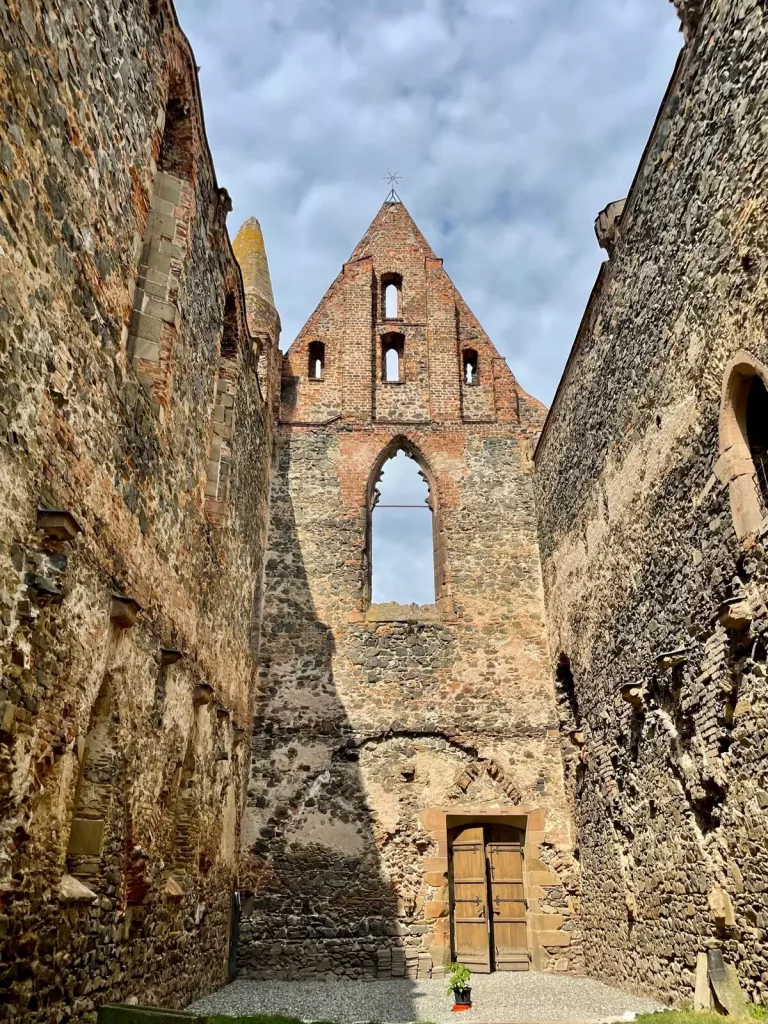
In the 14th century, the area underwent significant reconstruction, a new Gothic monastery church was built and a quadrature with a paradise courtyard, which still today feels like paradise. It invites you to sit in one of the glass windows and look at every single plant that climbs the wide monastery walls. A monastery castle was also built on a nearby hill.
However, according to historians, all these constructions may be one of the reasons why the monastery went into debt.
The economic situation of the monastery stabilized soon after founding, and it received the protection of the Pope himself and the
Czech monarchs.But after a local priest Martin Göschl married one of the nuns, it saw a total collapse in order. The place of devoted faith became a place of sin and orgies.
Göschl was arrested and, according to legend, the villagers eventually expelled the sinful nuns from the convent. They even killed some, and legend has that one is still trapped in the walls.
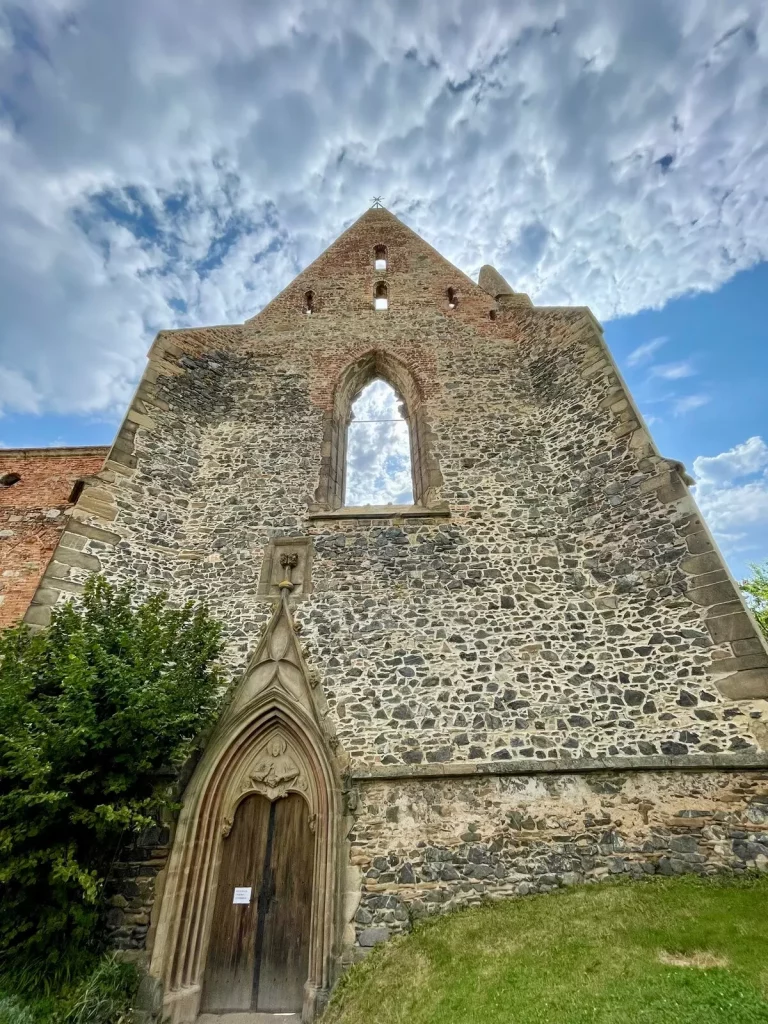
After the nuns scattered throughout the kingdom, the estate fell into the lap of the monarch Ferdinand I of Habsburg. However, he sold it in 1537 to the Vice-Chancellor of the Czech Kingdom, Jiří Žabko from Limberk. The manor changed owners a few more times, but after the fire in 1703 it was rather dilapidated. The building was ravaged by passing troops, non-leavers and the manor officials themselves over the next few centuries.
Restoration began in the early 20th century, however, and since 1990 the site has been open to the public.
Despite everything that people have done to it, even today the ruin has its charm, which people from all over the country come to draw here.
You can see, for example, the uncovered torso of the church gable, the Garden of Eden and the high vaulted ceilings. But you can also walk through the monastery garden and think about how the nuns lived and whether they went to dip their feet in the nearby stream in the summer.
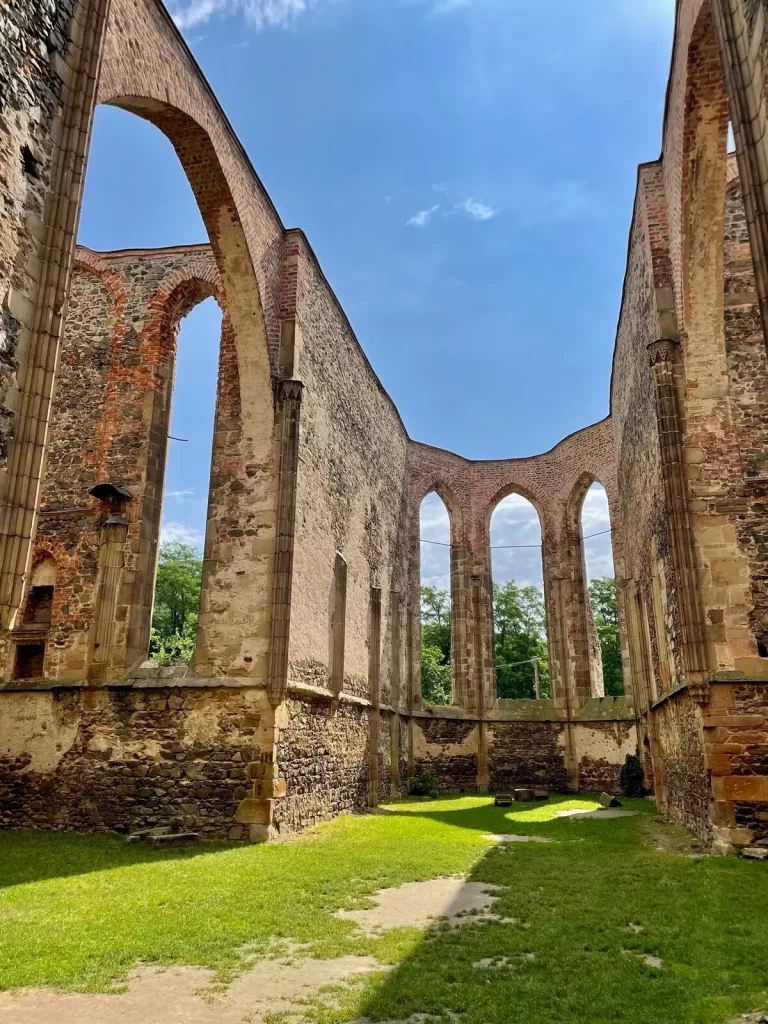
Do you already know where you’re going this weekend? If not, we have some tips for interesting experiences in Prague.
House of rest
Monday, July 4 to Sunday, July 10, Prague 8
Let yourself indulge in the Karlin ALTA Studio and their Rest House. Over seven days, they want to share a temporary refuge for the tired, and offer an oasis of lounging. The organizers say their goal is to create a space where it will be possible to cultivate a worldview that does not just see rest as a tool for doing more work.
The program will be devoted to undisturbed rest in a room full of blankets and pillows, supplemented by various practices and conversations that enable relaxation to be actively experienced and critically reflected upon. It will be open from 3 pm on weekdays, from 2 pm on weekends, and closes at 9 pm.
Prague ZOO
July and August, Prague 7
During the summer, the Zoo organizes regular guided feedings and meetings with the animals every day. You can catch up with your favorites when they are most active and learn more about their interesting lives. At 11:00 the penguins always get their share of food, at 12:00 there is a meeting with the gorillas and at 13:30 you can move to the giraffes, among others. Check out the full schedule.
For the trip to the Prague Zoo, you can use the Prague Steamship Company. It leaves from Rašínovo embankment at 9:00 a.m., 12:00 p.m. and
3:30 p.m.
Landscape festival
Wednesday, June 22 to Sunday, October 2, various locations
Walk through four locations where you will find dozens of artistic and architectural interventions and works. This year, the Landscape
festival focuses on revitalizing Prague’s railway stations and infrastructure hubs. The program also includes exhibitions, expert debates and guided walks.
Paddleboards in Center Černý Most
until Wednesday, July 20, Prague 9
In front of the western entrance to the shopping center you will find a new swimming pool with a length of 14 meters. Try paddleboarding and learn something about the sport. You can also take part in paddling and yoga lessons on paddleboards with professional instructors for free.
Play Sports in Metropole Zličín
Wednesday, June 29 to Saturday, September 24, Prague 5
Metropole Zličín has prepared a sports zone for the entire summer, which offers a beach volleyball court, a bouldering area, a hexagonal cage for soccer and basketball, table tennis, a slackline, a wading pool for children and a rest area with sunbeds and umbrellas. Entrance and equipment rental is free, and playground reservations and regular lessons are charged.
Outdoor game Stínadla II
Friday, April 1 to Wednesday, August 31, Prague 1
Do a scavenger hunt in Stinalda! The blind map of Stínadel contains 16 locations where individual tasks must be completed. The goal is to get 16 unique shader memory cards and solve the final secret. It is not necessary to visit all the mysterious places in one day–the game can be divided into several walks. The Stínadla II map, rules and card case are available for purchase at the box office of U Zlatého prstenu.
Passengers can now pay for a sightseeing ride in one of the oldest trams via one of the most modern mobile terminals.
The historic tram line number 42, operated by Prague City Tourism, transports tourists to and from popular Prague sights.
Passengers can now pay for the ticket via the mobile payment card acceptance application from the Global Payments service provider. They can pay even in cryptocurrencies.
Petr Soukup, Director of IT at Prague City Tourism, adds: “We see the introduction of mobile terminals as a big step forward. The terminals will significantly speed up the ticket purchase process and at the same time provide tourists with a more convenient payment alternative. Unlike cash, almost everyone has a credit card with them.”
Future payments
“Cryptocurrencies are a very popular source of money today. There is no reason why people should not use them for regular payments. They can now pay for a ticket with a piece of bitcoin or, for example, Ethereum,” adds Soukup. A huge advantage of Global Payments and GoCrypto is that the customer pays in the crypto, but the merchant can choose whether to accept payment in cryptocurrency or in a traditional currency, such as Czech crowns.
According to his instructions, Global Payments will send the entire amount either to his crypto-wallet or to his bank account. So the trader has no worries about receiving cryptocurrencies, everything works completely automatically.
The summer season is approaching
The tourist tram line, in which a 24-hour ticket is valid and passengers can get on and off at any time, leads through the historical center of Prague.
Passengers will get to see, for example, the Powder Gate, the towers on Charles Bridge, and the Prague Castle. During normal operations, the tram runs only on weekends. In the summer season from June 23, however, it will be extended and those interested can use it from Thursday to Sunday at 40-minute intervals.
“We included the tourist tram last year as a benefit of the summer program in Prague as at home. Despite the fact that the season was weakened due to the covid, the interest in sightseeing rides exceeded our expectations. This year we assume that we have a relatively promising summer season ahead of us. We decided to strengthen tram connections for the next few days during the holiday days,” concludes spokeswoman Klára Malá from Prague City Tourism.
Prague 6 received a gift from Ukrainian citizens in the form of five red viburnum.
The flowers serve as a thank you for accommodation, help, and support during the ongoing war.
Mayor Ondřej Kolář (TOP 09) took over the planting of the trees together with the Ukrainian ambassador Yevhen Perebyjnis. Ukrainian
women, who found asylum in the city district, accompanied the ceremony by singing the folk song Red Viburnum.
Mayor Ondřej Kolář wished for the bushes to take root–thus far, they are doing well. He also hopes that they will find the right home in the territory of Prague 6, just like many people from Ukraine before them.
The song is sad but optimistic and has become a symbol of Ukrainian pride and resistance during the war with Russia.
The song Red Viburnum served as the anthem of the Ukrainian Voluntary Legion during World War I. There are several versions of this folk
song with original adaptations. There are also many theories about who its original author is.
It is most often attributed to Mikhail Hajvoronsky, but modern musicologists are unsure about its true origins.
“The red viburnum has been a symbol of Ukraine for centuries and nowadays also a symbol of the Ukrainian resistance. This beautiful song is sad and at the same time optimistic, it says that even though Ukraine is going through a difficult period, it will continue to exist. I am convinced that we will win the war that Russia has waged because we have a brave army and friends all over the world who stand behind us,” said the Ambassador of Ukraine Yevhen Perebyjnis.
The song gained international acclaim in March 2022, when it was recorded in a cappella version by Andrij Chlyvňuk from the band Boombox during a tour of the USA.
The remix of the South African musician The Kiffness has also become popular. Figure skaters Olexandra Nazarova and Maxim Nikitin also performed with her at the 2022 World Championships as part of the protest against the invasion.
The red viburnums now will serve as a reminder for all the Czech goodwill during these difficult times, as well as of home for Ukrainian refugees who may stay for many months in the Czech Republic.
Vinohrady was established on a vast empty hill behind Prague. It sports wide boulevards intertwined with parks, making it one of the most prestigious neighborhoods to live in.
This is true today, as it was a hundred years ago when the then independent city was swallowed up by the newly formed metropolis – Greater Prague.
Vinohrady consists of typical city blocks of houses, but also hides a unique residential area, where the former Prague elite lived. Prague, Brno, Moravian Ostrava, Bratislava, Královské Vinohrady. These were the largest cities in Czechoslovakia in 1921. At that time, there were 90,000 inhabitants in Vinohrady (in 1930, 95.5 thousand).
It had seen rapid growth, with only one-sixth of this number living here forty years ago on a hill east of the Vltava banks, behind the walls of the New Town of Prague. A century ago, the fifth-largest city in the republic joined the newly formed Greater Prague and immediately became one of the most attractive districts – which it remains.
In the autumn of 2021, Vinohrady even ranked 32nd in a ranking of the most “cool” districts in the world by the international magazine Time Out.
This part of the city, in the shape of a fire ax, benefits primarily from the wide streets and many parks. Notably: the orchards of Svatopluk Čech or the Čapek brothers, Jiřího z Poděbrad Square, Míru Square or the large Grébovka, and the Riegerovy sady park with its large beer garden.
Several centuries ago, the rolling landscape of the future Královské Vinohrady was dominated by vineyards, which lend the district its name, translated as “Royal Vineyards. A little later, it was all fields, meadows, gardens, orchards and farmsteads.
Gradually, summer residences began to appear, so that everything in the second half of the 19th century was absorbed by the typical urban development with the center around today’s Peace Square – including the neo-Gothic church of St. Ludmila (1893), the Neo-Renaissance Theater (1909) or the National National House (1894).

A view of Hradešínská Street, where a residential area began to emerge at the end of the 19th century. Vinohrady brewery on the right. Year 1908.
The area from Nové Město to the eastern border of Vinohrady was crossed by the main streets, the French, Russian, Crown and Vinohrady, respectively, which copied the old road to Kutná Hora. In many cases, the elevation change was compensated for by digging the soil or weighing it.
For example, from Korunní Street to the current Vinohradská. The construction boom of unprecedented proportions is related, among other things, to the declaration of Prague as an open city in 1866, which brought not only the demolition of the walls, but also the lifting of the ban on construction activities in the belt around them.
The former Viniční Hory was renamed the Royal Vinohrady Village in 1867, in 1875 a large area was divided, when the future Žižkov separated, and four years later Vinohrady became a town. Zizkov gained the status of a town only in 1881.
After the beginning of the demolition of the Prague walls in the early 1970s, housing construction of the growing middle and upper classes developed here from the National Museum. Three years before the end of the century, a tram line between the Museum and Flora was put into operation.
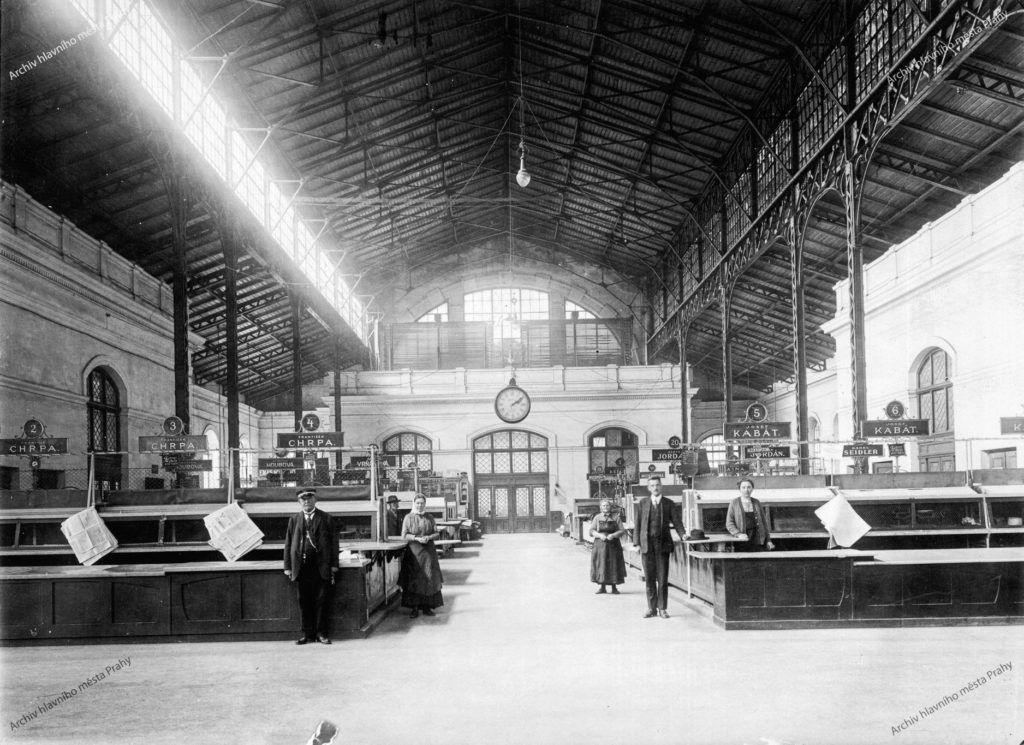
View of the interior of the Vinohrady market. Around 1915.
Vinohrady grew mainly from the 1920s to the 1980s, when construction continued further east, to Ohrada and Malešice. In the places where Královské Vinohrady–built mainly on an elevated plain–slopes south towards the river Botič to Vršovice is where, at the turn of the 19th century, a distinctive district of magnificent villas began to emerge.
The slope, framed at the top by Korunní Street and at the bottom by Ruská třída, experienced its boom in the 1920s and 1930s when the district was inhabited by advanced intellectuals, writers, composers, sculptors, and architects, who also brought a new architectural style – modernism.
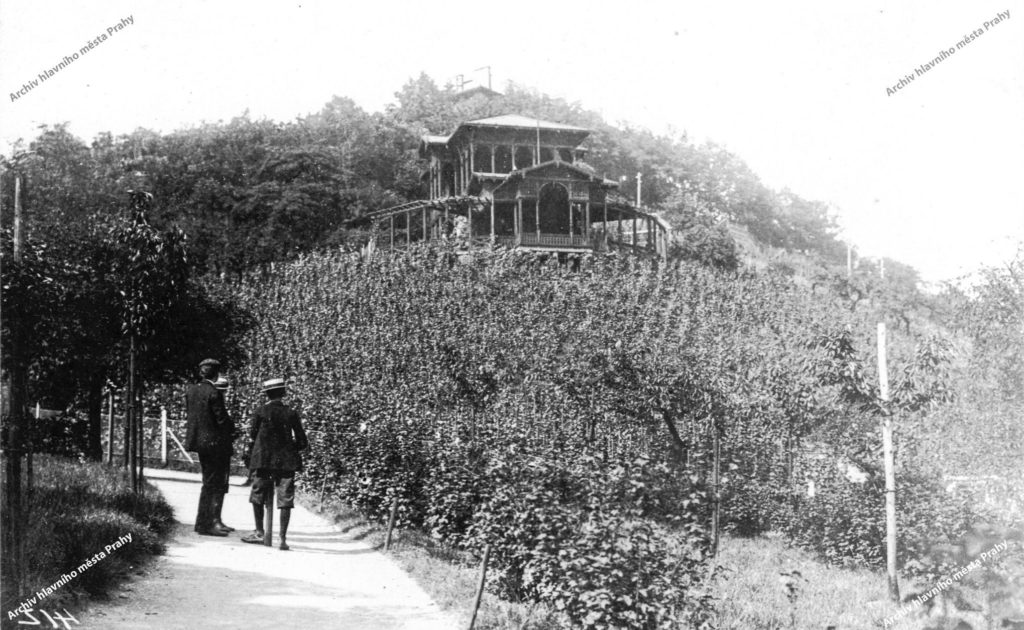
Pavilon Grebovka. Around 1910.
The villa was built here by the famous architect Jan Kotěra, the Čapková brothers – painter Josef and writer Karel, librettist Adolf Wenig, graphic artist and set designer of the Liberated Theater František Zelenka, post-surrealist painter Zbyšek Sion or sculptor Ladislav Šaloun, author of the monumental monument of Jan Hus on the Old Town Square.
Important buildings in Vinohrady include the Church of the Sacred Heart of the Lord from the turn of the 1920s and 1930s by Slovenian architect Jože Plečnik, which stands on Jiřího z Poděbrad Square, the market building on Vinohradská třída, the Neo-Renaissance water tower in Korunní and the adjacent church of the Czechoslovak Church in years 1930-1933, built in Dykova street according to the project of architect Pavel Janák.
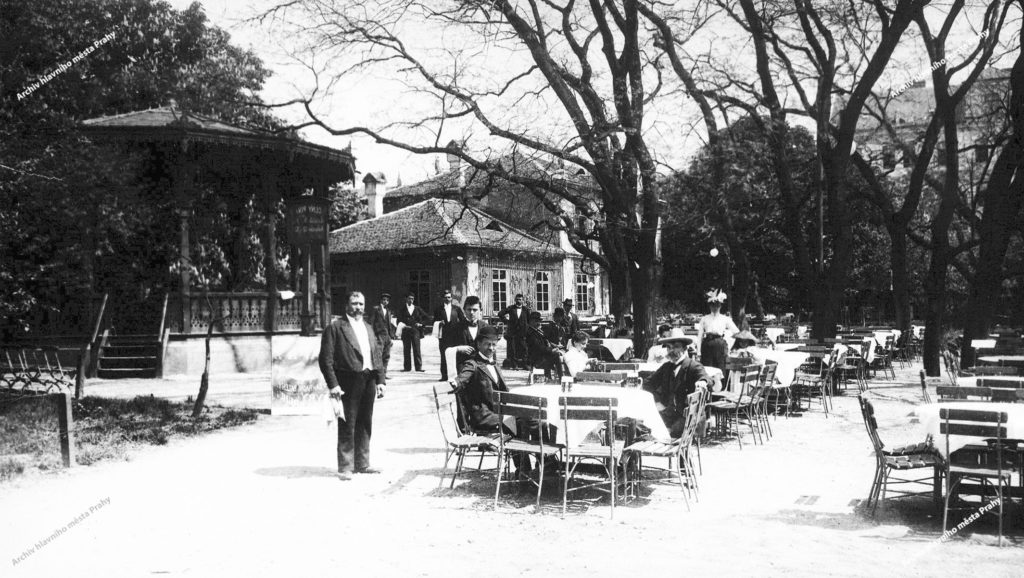
View of the garden restaurant in Riegrovy sady. Around 1905.
